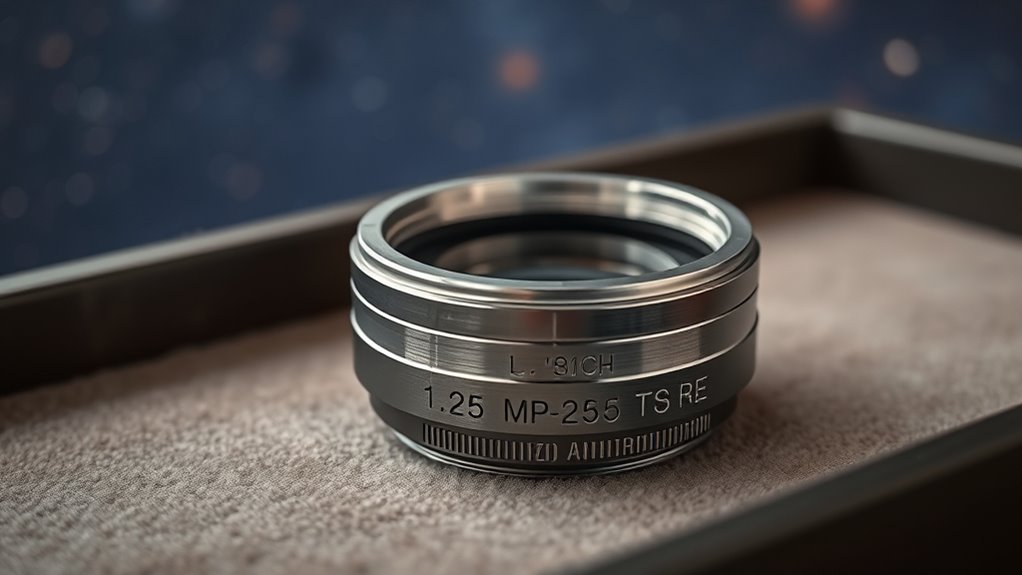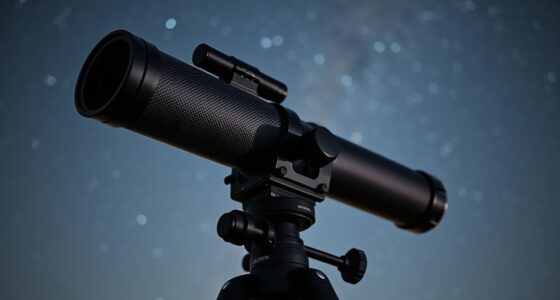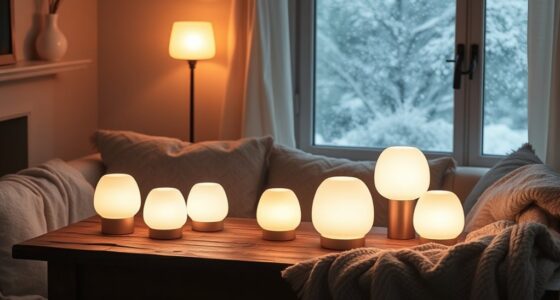If you’re after the best 1.25-inch focal reducers for sharper, brighter astrophotography, I recommend looking into models like the SVBONY 0.5X and Celestron Focal Reducer & Field Corrector. These offer high-quality, fully multi-coated optics that provide wider fields, better brightness, and reduced chromatic aberration. Compatibility with standard accessories makes them a versatile choice for visual and imaging use. Stick around to discover more options and tips to enhance your astrophotography setup.
Key Takeaways
- Look for models with full multi-coated optics to maximize light transmission and image brightness.
- Choose reducers with proven optical designs that minimize chromatic aberration and edge distortion.
- Prioritize durable construction with CNC-machined or anodized aluminum for longevity and environmental resistance.
- Ensure compatibility with standard 1.25-inch threading for easy attachment to your telescope, filters, and cameras.
- Consider user reviews and expert recommendations highlighting sharper, brighter images and minimal vignetting in astrophotography.
SVBONY 0.5X Focal Reducer for Telescope Eyepiece
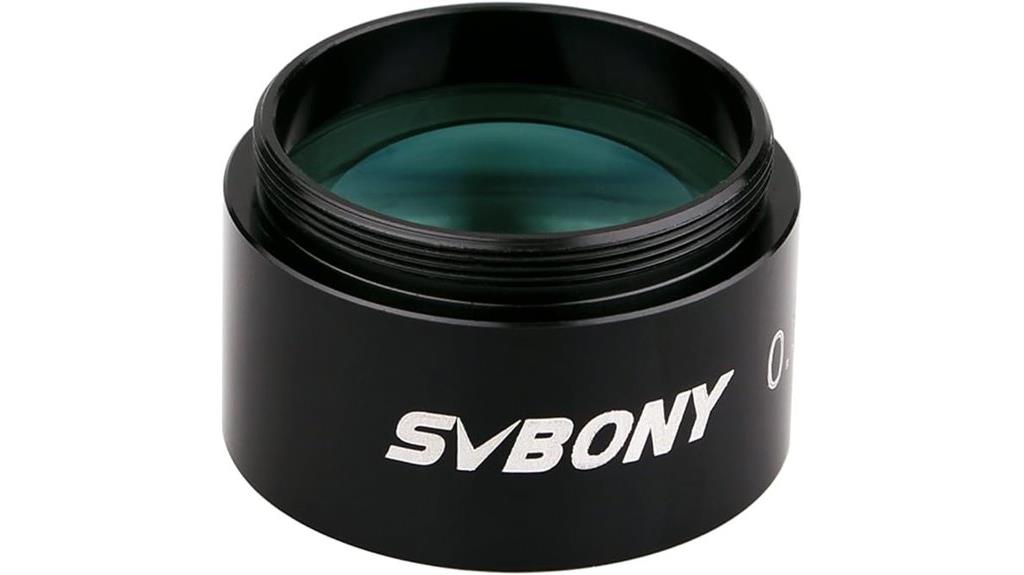
If you’re looking for an affordable and straightforward way to expand your telescope’s field of view, the SVBONY 0.5X Focal Reducer is an excellent choice. It features a 1.25-inch fully multi-coated design that connects directly to eyepieces, filters, or cameras. Made from fully metal, it’s durable and easy to handle. By reducing the focal length by half, it widens your field of view and decreases magnification, making it ideal for astrophotography and visual observation. It also concentrates more light onto your sensor, speeding up imaging. While edge distortions can occur, it’s a cost-effective tool for amateur astronomers wanting more expansive views.
Best For: amateur astronomers and astrophotographers seeking an affordable, easy-to-use focal reducer to expand their telescope’s field of view and improve imaging speed.
Pros:
- Fully multi-coated 1.25-inch metal design for durability and optimal light transmission
- Effectively reduces focal length by 50%, increasing FOV and decreasing magnification for wider views
- Easy to connect directly to eyepieces, filters, or digital cameras with standard threading
Cons:
- May introduce edge distortions, vignetting, and star elongation without additional field flatteners
- Compatibility issues can arise with certain DSLR cameras requiring spacers or adapters
- Optical quality at the edges can suffer, especially if used outside recommended parameters
SVBONY 0.5X Telescope Focal Reducer
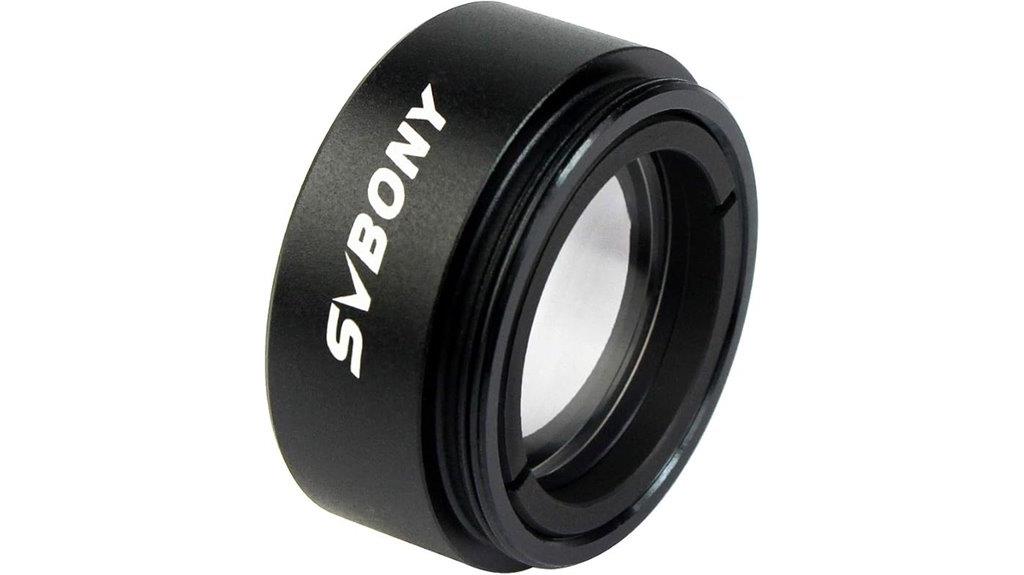
The SVBONY 0.5X Telescope Focal Reducer is an affordable option for amateur astronomers seeking to expand their field of view and shorten exposure times in astrophotography. It features a 1.25-inch filter thread and fits standard eyepieces, cameras, and diagonals, reducing focal length by half. Despite its compact, lightweight design, some users report threading issues and optical distortions like chromatic aberration and vignetting, especially at the edges. While it’s a budget-friendly choice with positive reviews for value and build, it may not deliver high precision for detailed astrophotography. Overall, it’s suitable for casual use and quick observations.
Best For: amateur astronomers and astrophotographers on a budget seeking to expand their field of view and simplify their setup for quick observations.
Pros:
- Affordable price point offering good value for casual use
- Compact, lightweight, and easy to handle and install
- Compatible with standard 1.25-inch eyepieces, cameras, and diagonals
Cons:
- Reports of threading issues and poor fit with some accessories
- Can produce optical distortions such as chromatic aberration and vignetting at the edges
- Not suitable for high-precision astrophotography or very fast telescopes
Astromania 0.5X Focal Reducer for Telescope
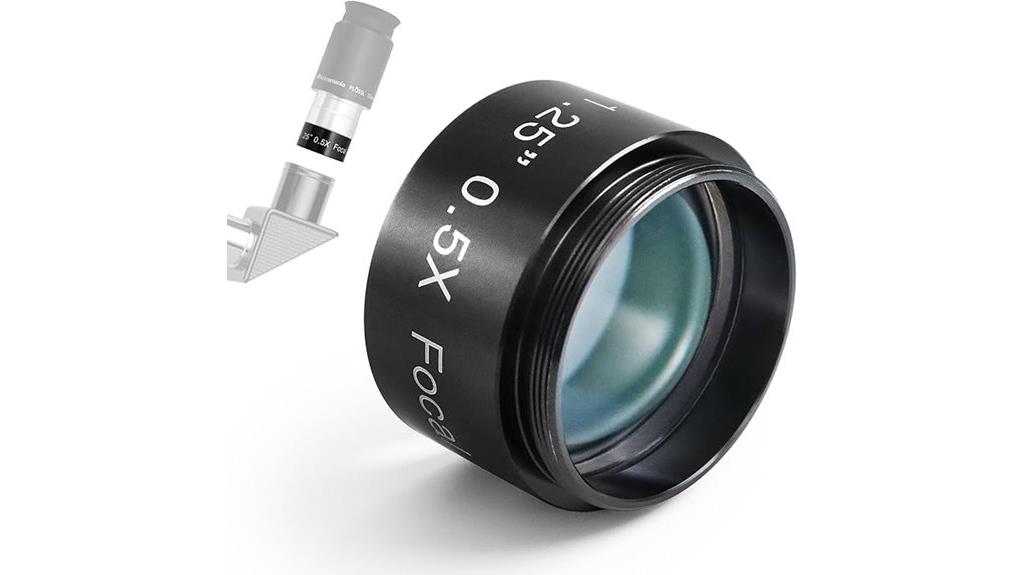
Designed for astrophotographers and visual observers seeking wider fields of view, the Astromania 0.5X Focal Reducer effectively halves your telescope’s focal length, making it easier to capture large sky areas like the Milky Way or full moon. It features an 85mm focal length with minimal distortion, thanks to its achromatic doublet lens. The compact, lightweight design fits standard 1.25-inch accessories and includes threaded filters for versatility. By reducing focal length, it allows for shorter exposure times and sharper images. Its solid build, affordability, and compatibility with various telescopes and cameras make it a popular choice for wide-field astrophotography.
Best For: amateur astronomers and astrophotographers seeking an affordable, lightweight accessory to expand their wide-field imaging capabilities with compatible telescopes and cameras.
Pros:
- Effectively halves the telescope’s focal length, enabling wider field of view for astrophotography and visual observation
- Minimal distortion with high-quality achromatic doublet lens, providing sharp, color-corrected images
- Compatible with standard 1.25-inch accessories, making it versatile and easy to integrate into existing setups
Cons:
- May require additional spacers or extension adapters to achieve proper focus with some telescopes
- Can produce halos around bright objects like the moon during nighttime imaging
- Not ideal as a substitute for high-quality field flatteners, and may introduce some field flatness issues or flare effects
Astromania 0.5X Focal Reducer for Telescope
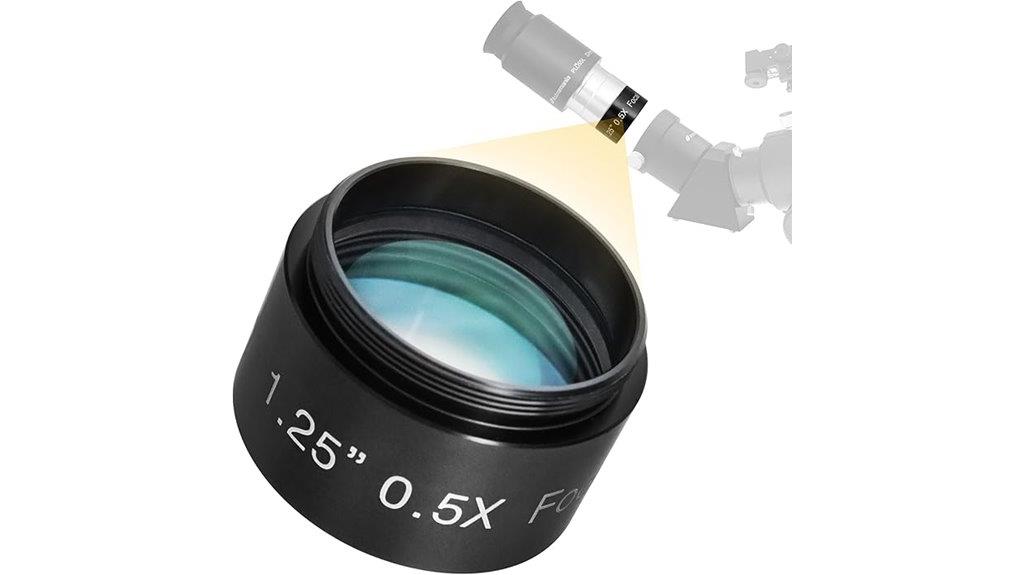
For amateur astronomers looking to expand their astrophotography capabilities without breaking the bank, the Astromania 0.5X Focal Reducer offers an effective and affordable solution. It reduces the telescope’s focal length by half, providing a wider field of view and lower magnification, which simplifies capturing deep-sky objects. Compatible with standard 1.25-inch threads, it’s easy to attach to eyepieces and camera adapters. Its fully multi-coated lenses improve image correction, while the durable black anodized aluminum housing ensures longevity. Rated highly for quality and value, this focal reducer makes astrophotography more accessible, especially for those working with longer focal ratio telescopes.
Best For: amateur astronomers and astrophotographers seeking an affordable, effective way to expand their telescope’s field of view and simplify deep-sky object imaging.
Pros:
- Fully multi-coated lenses for improved image correction and quality
- Easy to attach via standard 1.25-inch threads, compatible with various accessories
- Halves the focal length, providing wider views and reducing exposure times
Cons:
- Potential vignette issues that may require flat frame processing
- Slight reduction in aperture size due to optical design
- Compatibility limited to telescopes with longer focal ratios and certain eyepieces
Celestron Focal Reducer & Field Corrector for Telescopes
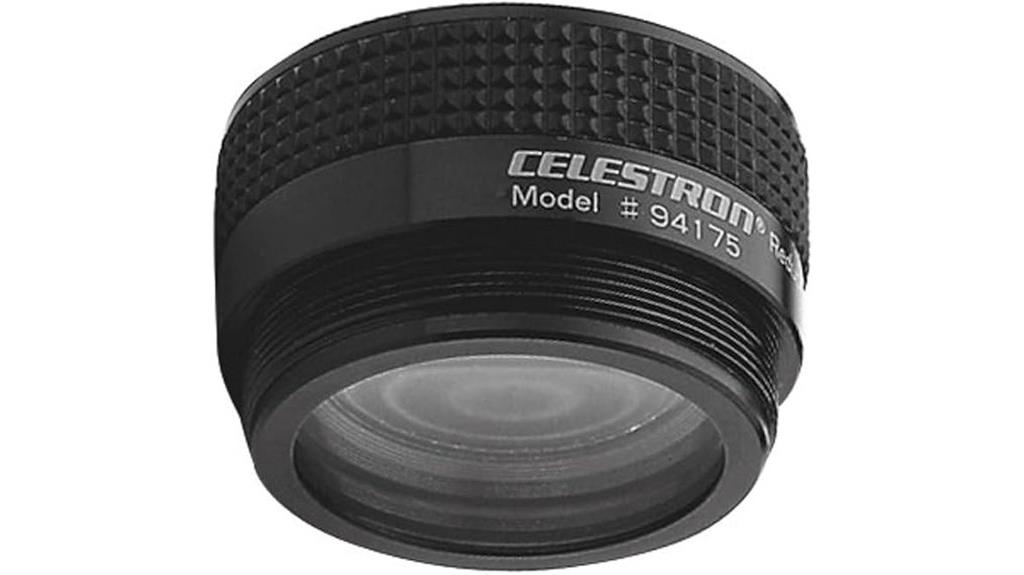
If you’re looking to enhance your Celestron Schmidt-Cassegrain telescope’s imaging and viewing capabilities, the Celestron Focal Reducer & Field Corrector is an excellent choice. It reduces the focal length and f/ratio by 37%, turning long focal SCTs into faster, wider-field instruments. Designed for C11 and C14 models, it threads onto the rear or reducer plate, allowing easy attachment of accessories like T-Adapters and star diagonals. It improves brightness, sharpness, and flatness across the field, making it ideal for astrophotography and visual observation. Its durable, machined aluminum construction and positive user feedback make it a popular, high-quality accessory for amateur astronomers.
Best For: amateur astronomers and astrophotographers seeking to enhance their Celestron Schmidt-Cassegrain telescopes with wider fields, increased brightness, and improved image flatness for both visual observation and deep-sky imaging.
Pros:
- Significantly reduces focal length and f/ratio by 37%, enabling faster imaging and wider views
- Improves brightness, contrast, and field flatness, enhancing overall image quality
- Durable, lightweight machined aluminum construction with easy threading and installation
Cons:
- May introduce slight edge aberrations with certain camera setups at the periphery
- Designed specifically for C11 and C14 models, limiting compatibility with other telescopes
- Requires removal for high-magnification observations where maximum detail is needed
Alstar 0.5X Reducer for Photography and Observing
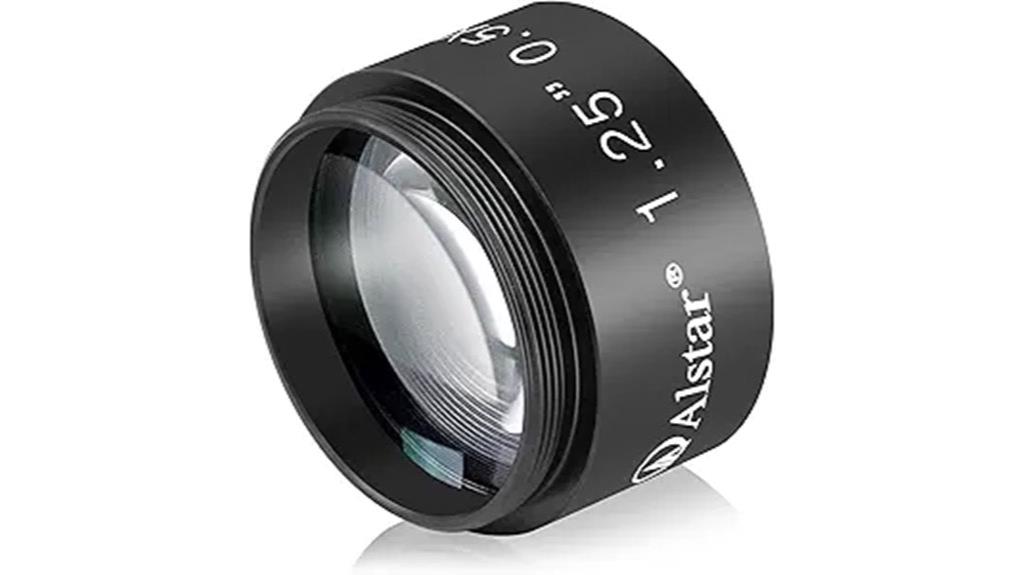
The Alstar 0.5X Reducer stands out as an excellent choice for amateur astronomers and astrophotographers seeking wider fields of view without investing in expensive wide-angle eyepieces. It effectively halves the focal length of your telescope, enabling broader views and shorter exposure times, which is perfect for deep-sky imaging and observing large objects like the Moon and Sun. Built with durable aluminum and featuring 1.25-inch filter threads, it’s compatible with a variety of accessories. Easy to stack for additional reduction, this affordable reducer improves your imaging and observing experience, especially with longer focal ratio telescopes. It’s a versatile tool for expanding your astrophotography capabilities.
Best For: amateur astronomers and astrophotographers seeking affordable, wide-field views and shorter exposure times for deep-sky imaging and large celestial object observation.
Pros:
- Effectively halves the focal length, expanding wide-field viewing capabilities
- Compatible with standard 1.25-inch filter threads and accessories
- Durable construction with aluminum housing and easy stacking for additional reduction
Cons:
- Not suitable as a field flattener, may cause edge warping in images
- Some users may initially mistake it for a flattener, leading to confusion
- Slight reduction in image brightness due to focal length reduction
SVBONY 1.25-inch 0.5X Focal Reducer for Telescopes
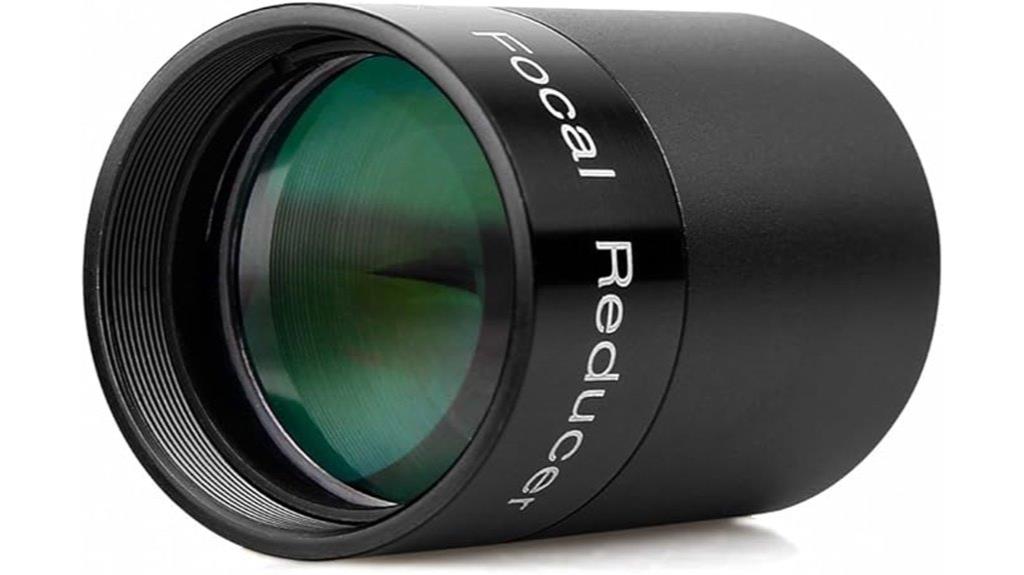
The SVBONY 1.25-inch 0.5X focal reducer is an excellent choice for astronomers looking to expand their astrophotography and observing capabilities. It provides a wider field of view and faster imaging by reducing the focal length by half. Designed for use with cameras, eyepieces, and CCDs, it includes a C-mount adapter compatible with standard video cameras. The fully threaded interior minimizes reflections, ensuring clearer images. Easy to install into standard 1.25-inch focusers, it’s perfect for capturing larger sky areas and achieving sharper, brighter images with less exposure time. This focal reducer truly enhances both visual observing and astrophotography sessions.
Best For: amateur astronomers and astrophotographers seeking to enhance their telescopic imaging with a wider field of view and faster system setup.
Pros:
- Provides a 0.5x reduction in focal length for wider field of view and faster imaging.
- Fully threaded interior minimizes reflections for clearer images.
- Compatible with standard 1.25-inch focus tubes and includes a C-mount adapter for easy connection to cameras.
Cons:
- May require precise threading and alignment during installation.
- Designed primarily for use with standard video cameras and CCDs, limiting compatibility with some specialized equipment.
- Slight reduction in image scale might not be suitable for high-magnification observations.
GSO 0.5X Focal Reducer 1.25 (31.7mm)
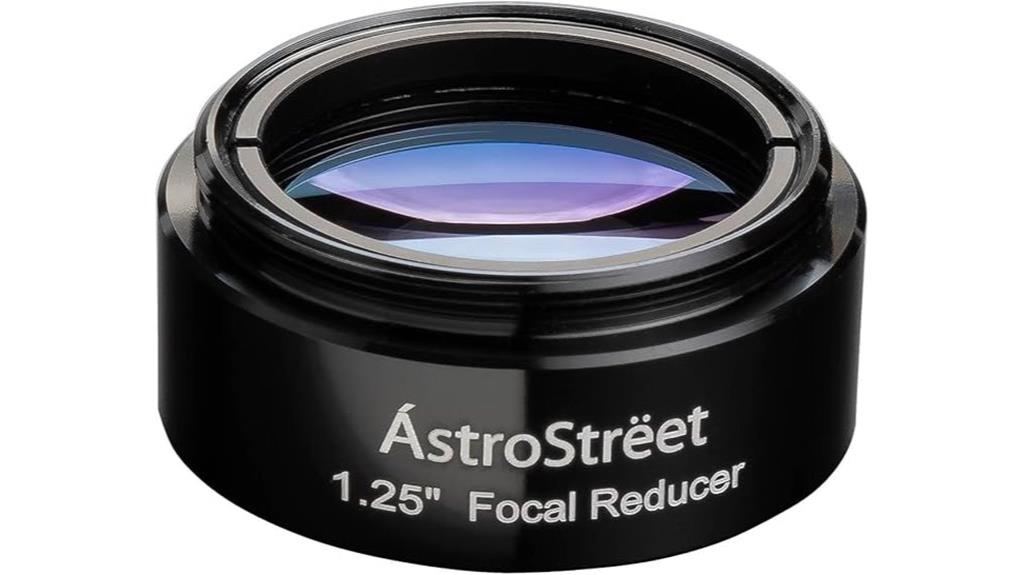
For amateur astronomers seeking to expand their viewing capabilities without investing in larger, more expensive equipment, the GSO 0.5X Focal Reducer 1.25 (31.7mm) offers an excellent solution. Made in Taiwan by the reputable Taiwan GS company, it features a CNC-machined aluminum body and Hooley multi-coated lenses for durability and light transmission. Weighing only about 0.6 oz, it’s compact and easy to attach. It effectively doubles the focal length, enlarging exit pupils and enhancing views of faint objects. While great for visual use, it can introduce vignetting and aberrations if not properly adjusted. Overall, it’s a reliable, affordable accessory for broadened skywatching.
Best For: amateur astronomers looking to enhance their visual observations with a cost-effective, high-quality focal reducer that simplifies setup and improves views of faint objects.
Pros:
- Crafted with CNC-machined aluminum and multi-coated lenses for durability and optimal light transmission
- Effectively doubles focal length, enlarging exit pupils and improving faint object visibility
- Compact, lightweight, and easy to attach, making it versatile across different telescopes
Cons:
- Can cause vignetting, aberrations, or star trailing if not properly adjusted or used with certain eyepieces
- Not ideal for astrophotography due to potential edge vignetting and image artifacts
- Requires precise back-focus adjustment to avoid focus issues or image quality degradation
Alstar C-Mount Reducer for CCTV Cameras and Telescopes
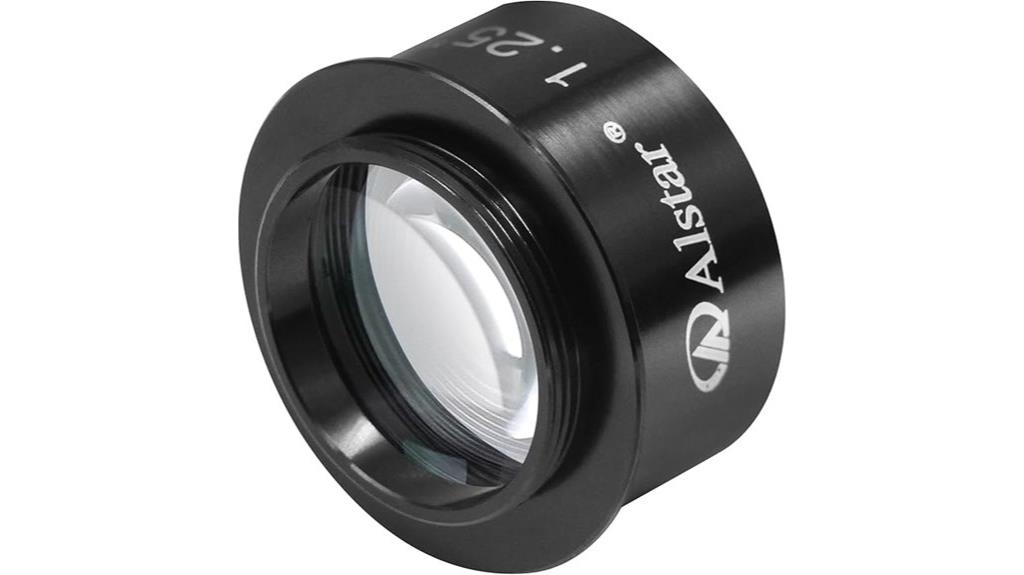
If you’re working with CCTV cameras or telescopes that use C-mount or 1.25-inch filter threads, the Alstar C-Mount Reducer is an excellent choice to expand your astrophotography and imaging capabilities. It offers a 0.5X focal reduction, effectively halving the focal length, which provides wider fields of view and shorter exposure times. Its 22.5 mm coated lens ensures better correction, especially when combined with spacers for additional reduction. The reducer mounts easily via standard 1.25-inch or C-mount threads, making it versatile for telescopes with longer focal ratios. Its compact, durable design makes it ideal for both astrophotography and CCTV applications.
Best For: astrophotographers and telescope enthusiasts seeking to reduce focal length and expand their field of view with CCTV cameras or telescopes using C-mount or 1.25-inch filter threads.
Pros:
- Provides approximately 0.5X focal reduction for wider fields of view and shorter exposure times
- Compatible with standard C-mount and 1.25-inch filter threads, ensuring easy integration
- Compact and durable housing made of anodized aluminum, suitable for portable use
Cons:
- May require spacers (sold separately) for additional focal reduction adjustments
- Designed primarily for telescopes with longer focal ratios, less effective with faster scopes
- Slightly limited aperture of 22.5 mm, which may restrict light gathering for some astrophotography needs
SVBONY SV157 Telescope Extension Tube (1.25 Inch, 34mm)
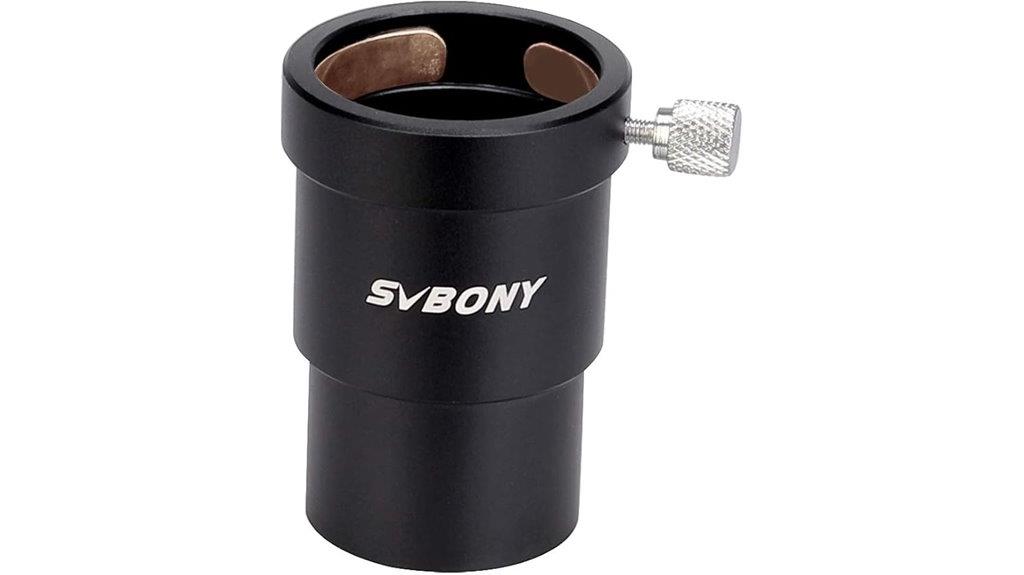
Looking to fine-tune your telescope’s focus and improve your astrophotography setup? The SVBONY SV157 Telescope Extension Tube is a solid choice. It extends focal length by 34mm and fits 1.25-inch focusers, eyepieces, and accessories. Made from durable anodized aluminum, it’s lightweight at just 40 grams, so it won’t add much burden. The fully threaded interior minimizes reflections, and the aluminum locking thumbscrews plus brass pressure ring secure your gear without marring. Compatible with filters and focal reducers, it helps achieve precise focus and proper back focus, making it ideal for guiding, imaging, and astrophotography. Users praise its build quality and ease of use.
Best For: amateur astronomers and astrophotographers seeking a lightweight, reliable extension tube to fine-tune focus and enhance imaging setups.
Pros:
- Durable anodized aluminum construction ensures long-lasting use
- Fully threaded interior minimizes reflections and stray light entry
- Lightweight design (40 grams) adds minimal burden to the setup
Cons:
- Some users may need to leave slight space for optimal focus adjustment
- Compatibility limited to 1.25-inch focusers and accessories
- May require careful handling to avoid cross-threading during attachment
Focal Reducer for Telescopes, 1.25 Inch 0.5X Threaded
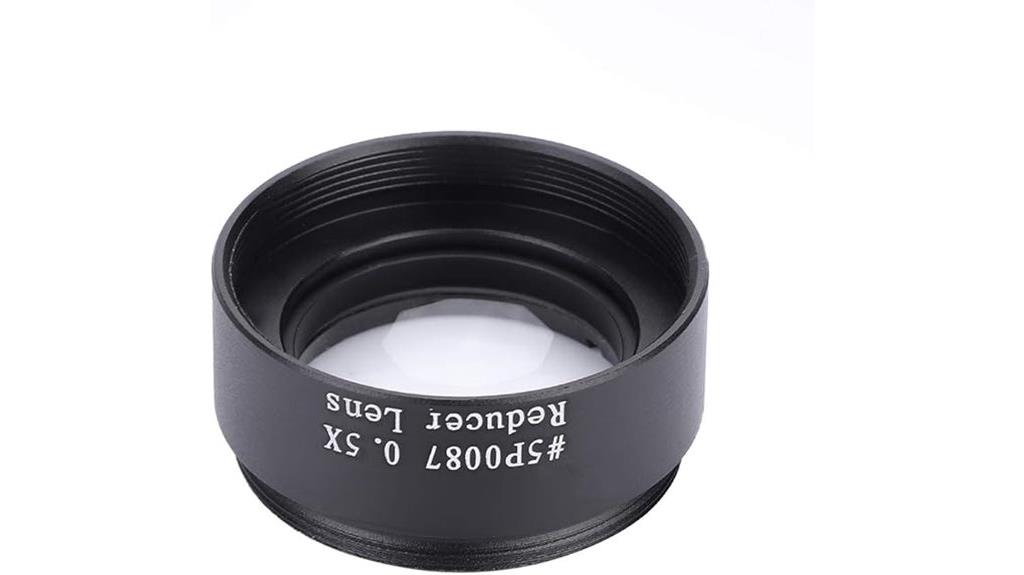
The Focal Reducer for Telescopes, 1.25 inch 0.5X threaded, is an excellent choice for amateur astronomers seeking to expand their viewing field and enhance their astrophotography capabilities. It diminishes focal length by half, providing a wider field of view and brighter images. Built with durable aluminum alloy and premium lenses, it guarantees clear, light-transmitting visuals. Compatible with standard 1.25-inch eyepieces and cameras, it supports filter attachment and threaded connections. Although ideal for longer focal length telescopes, it’s compact, lightweight, and easy to install, making it a versatile accessory for both observation and astrophotography.
Best For: Amateur astronomers and astrophotographers looking to expand their field of view and improve image brightness with compatible 1.25-inch telescopes and eyepieces.
Pros:
- Effectively reduces focal length by 0.5X, providing a wider field of view for detailed observation.
- Made with durable aluminum alloy and premium optical lenses for long-lasting use and clear images.
- Supports filter attachment and threaded connection, enhancing versatility for astrophotography and observation.
Cons:
- Not recommended for very fast telescopes or wide-angle eyepieces, limiting its use in some setups.
- Slightly limited compatibility with certain telescope types that require different reduction ratios.
- The compact size may require careful handling during installation to avoid misalignment.
0.5 Focal Reducer/Field Flattener for Starshoot Imaging Cameras
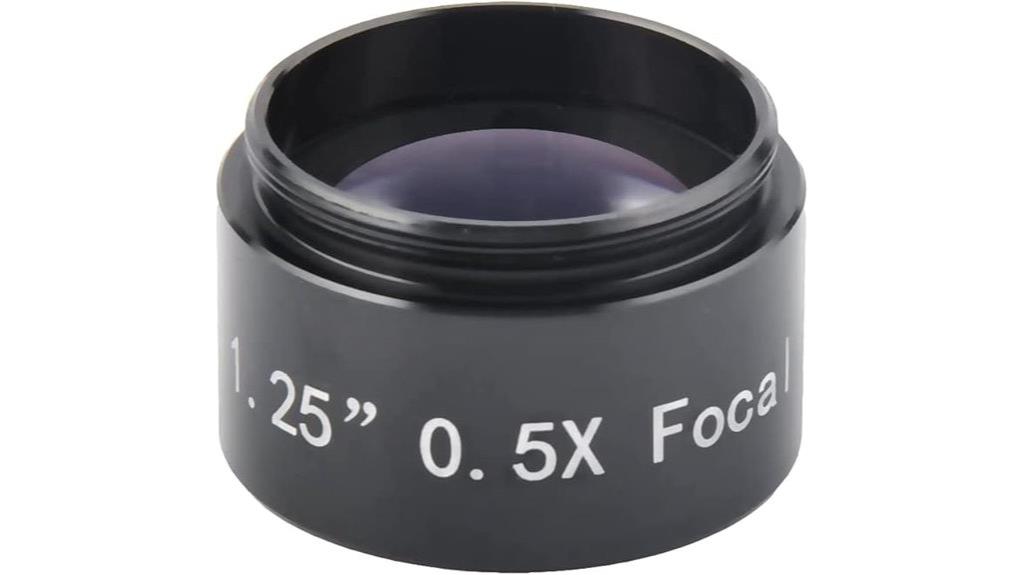
For amateur astronomers seeking to expand their imaging capabilities, the Celticbird 0.5 Focal Reducer/Field Flattener stands out as an excellent choice. It reduces the telescope’s focal ratio by half, offering a wider field of view that’s perfect for capturing large starfields or deep-sky objects. Compatible with 1.25-inch accessories, including eyepieces, diagonals, and camera adapters, it’s versatile and easy to integrate. Its two-element optical lens transmits more light, acting like a reverse Barlow lens to enhance image coverage. The durable anodized aluminum housing ensures longevity, and standard threading makes it compatible with most equipment, making it a valuable tool for astrophotographers.
Best For: amateur astronomers and astrophotographers looking to expand their imaging capabilities with wider field views and enhanced light transmission.
Pros:
- Reduces focal ratio by 0.5 for wider field imaging of large starfields and deep-sky objects
- Compatible with 1.25-inch accessories, ensuring versatile integration with various equipment
- Durable anodized aluminum construction provides long-lasting use
Cons:
- Slight green sheen may require adjustments for color accuracy in images
- Only compatible with 1.25-inch accessories, limiting use with larger diameter equipment
- Slightly increased complexity in setup for beginners unfamiliar with astrophotography accessories
SVBONY 0.5X Focal Reducer for Astronomical Telescopes
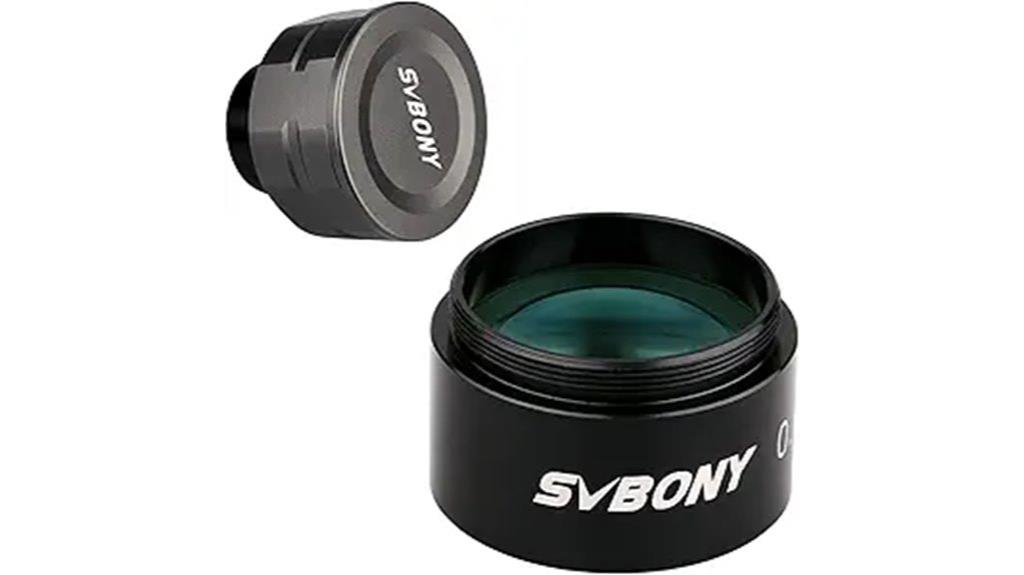
If you want to expand your view of the night sky without sacrificing image quality, the SVBONY 0.5X Focal Reducer is an excellent choice. This 1.25-inch, fully multi-coated reducer cuts your telescope’s focal length in half, offering a wider field of view perfect for both visual and astrophotography. Its durable metal casing and FMC optical glass ensure durability and maximum light transmission, delivering brighter, clearer images. Compatible with the SV205 planetary camera, it supports high frame rates and high-resolution video recording. Whether capturing deep-sky objects or planetary details, this focal reducer simplifies your setup and enhances your imaging experience.
Best For: amateur astronomers and astrophotographers seeking to expand their field of view and improve image clarity during celestial observations and imaging.
Pros:
- Fully multi-coated FMC optical glass ensures high light transmittance and bright, clear images.
- Durable metal casing provides robust protection and long-lasting use.
- Compatible with the SV205 planetary camera, supporting high frame rates and high-resolution video recording.
Cons:
- Designed specifically for 1.25-inch focus telescopes, limiting compatibility with larger or different sized setups.
- May require additional adapters for use with other camera models or accessories.
- Some users might find the plug-and-play setup less flexible for advanced or custom configurations.
1.25 Inch to CS Mount Adapter for Telescopes
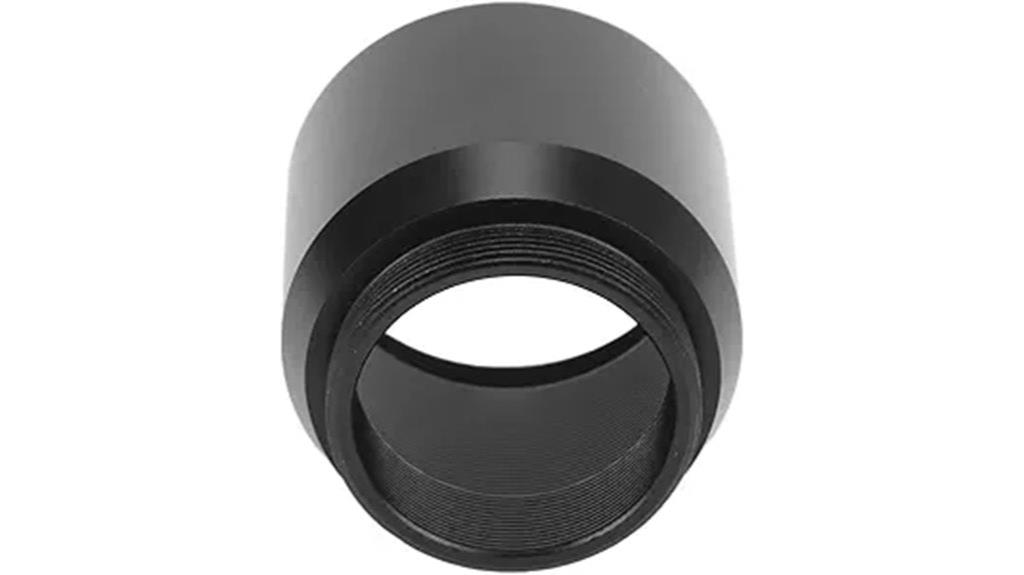
A 5 inch to CS mount adapter is essential for astronomers and astrophotographers seeking seamless integration between their telescopes and modern camera systems. This adapter connects 1.25-inch telescope eyepiece tubes to C or CS mount camera lenses, allowing for versatile setup options. Made from durable black anodized aluminum, it reduces stray light reflections and guarantees long-lasting performance. Its precise threads—M25x0.75mm on the outside and M28.6×0.6mm inside—securely attach filters, focus reducers, and extenders. Compact and lightweight at just over half an ounce, this adapter offers reliable connectivity for enhanced imaging and astrophotography experiences.
Best For: Amateur astronomers and astrophotographers seeking a reliable, versatile adapter to connect 1.25-inch telescope eyepieces with C or CS mount cameras for enhanced imaging capabilities.
Pros:
- Made from durable, black anodized aluminum for longevity and reduced stray light reflections
- Precise threading (M25x0.75mm external, M28.6×0.6mm internal) ensures secure attachment of filters and extenders
- Compact and lightweight design (just over half an ounce) for easy handling and versatile use
Cons:
- May require additional adapters for certain telescope or camera models
- Limited to 1.25-inch telescope eyepiece tubes and C/CS mount camera compatibility
- Small size could be prone to misplacement or loss during setup
SVBONY SV157 Telescope Extension Tube 1.25 Inch
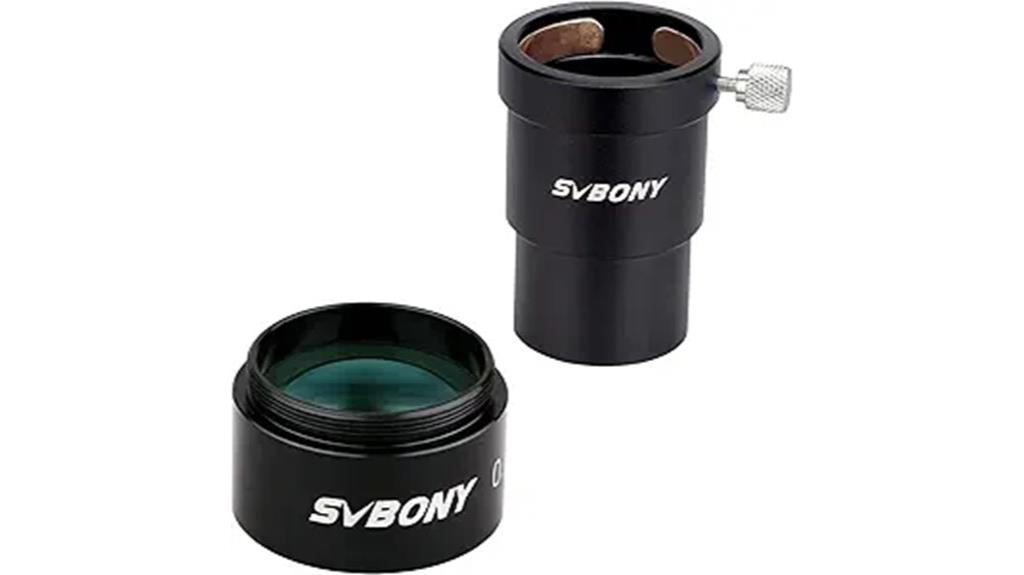
The SVBONY SV157 Telescope Extension Tube 1.25 Inch is an excellent choice for amateur astronomers seeking a versatile and durable accessory to enhance their viewing and imaging sessions. Its 34mm optical length and lightweight, compact design make it compatible with standard 1.25-inch focusers, eyepieces, and filters. The fully threaded interior reduces reflections, boosting image quality. It includes a 0.5x focal reducer, offering a wider field of view ideal for astrophotography and visual observation. Made of anodized aluminum with brass components, it’s built to last and protect your equipment. Overall, it’s a reliable, practical extension tube that improves both clarity and convenience during your stargazing adventures.
Best For: amateur astronomers and astrophotographers looking for a durable, versatile extension tube to enhance their telescope setup and imaging capabilities.
Pros:
- Fully threaded interior minimizes reflections, improving image clarity
- Includes a 0.5x focal reducer for wider field of view and easier astrophotography
- Constructed from durable anodized aluminum with brass components for longevity and equipment protection
Cons:
- Compatibility limited to 1.25-inch focusers and accessories
- Slightly heavier than plastic alternatives, may add some weight to the setup
- Requires careful handling to avoid damaging the fully threaded interior or brass components
Factors to Consider When Choosing a 1.25 Inch Focal Reducer
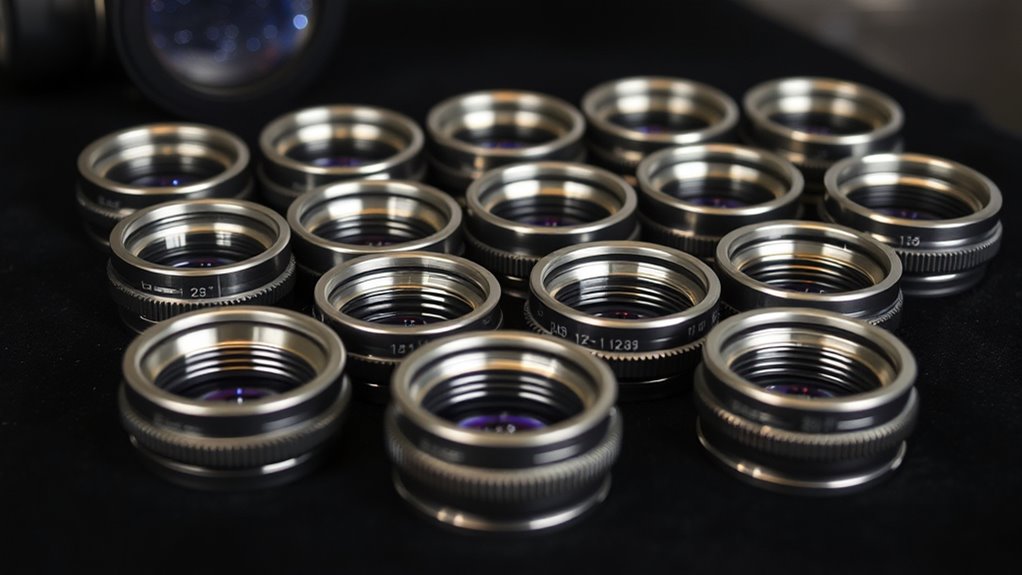
When selecting a 1.25-inch focal reducer, I consider how well it matches my equipment to guarantee compatibility. I also look at optical quality, durability, and how easy it is to install, so I get reliable performance without hassle. Understanding these factors helps me choose a reducer that best fits my needs and setup.
Compatibility With Equipment
To guarantee your focal reducer works seamlessly with your equipment, it’s crucial to check compatibility factors like threading, connection types, and size. Ensure the reducer has compatible threading, such as 1.25-inch or M28.5×0.6mm, matching your telescope and accessories. Verify that the connection type—whether filter thread, C-mount, or CS-mount—fits your camera, eyepiece, or adapter. It’s also important to review back focus requirements; some setups need spacers or extensions to achieve proper focus. Additionally, consider the optical design and coatings, making certain they’re suitable for your telescope and intended use, like astrophotography or visual observation. Finally, confirm the reducer’s size and weight are compatible with your mount to maintain stability during use.
Optical Quality Standards
Optical quality is a critical factor when selecting a 1.25-inch focal reducer, as it directly affects the clarity and brightness of your images. High-quality reducers feature fully multi-coated lenses that boost light transmission and contrast, resulting in sharper, brighter images. The construction of the lens system—such as air-spaced doublets or triplets—plays a vital role in minimizing aberrations and maintaining sharpness across the entire field. Low levels of chromatic aberration, distortion, and vignetting, especially at the edges, are essential for high-quality results. The material quality of optical elements, like high-transmittance optical glass, further enhances image clarity. Additionally, precise manufacturing tolerances and proper alignment of components are crucial to ensure consistent performance and prevent image degradation.
Focal Reduction Ratio
The focal reduction ratio determines how much a 1.25-inch focal reducer diminishes your telescope’s focal length, directly influencing the field of view and magnification. Common ratios like 0.5x, 0.6x, or 0.8x offer different levels of reduction. A 0.5x reducer halves the focal length, providing a wider field ideal for capturing expansive deep-sky objects, though it can sometimes cause optical distortions at the edges. Higher ratios, such as 0.8x, offer more moderate reductions, balancing field size and image quality. The choice depends on your specific observing goals and telescope setup. Matching the reduction ratio with your focal length and intended use ensures better image performance, minimizing issues like focus difficulty or edge distortions.
Build Durability and Material
Choosing a durable 1.25-inch focal reducer means prioritizing high-quality materials and solid construction. Look for models made from CNC-machined or anodized aluminum, which offer strength and resistance to corrosion over time. Fully multi-coated optical glass elements not only protect the lenses but also guarantee lasting optical performance. The housing should be robust, with precision threading and secure fittings to prevent wear and damage. A lightweight yet sturdy design reduces strain on your telescope’s focusing mechanism, maintaining durability without adding weight. Additionally, a strong, corrosion-resistant finish like black anodizing provides extra protection against scratches, dust, and environmental elements. These features collectively guarantee that your focal reducer remains reliable, functional, and durable throughout extensive use.
Ease of Installation
When selecting a 1.25-inch focal reducer, guaranteeing it’s easy to install can save you time and frustration. I look for models with compatible threading, like standard 1.25-inch or specific metric threads, to make attaching to my telescope straightforward. A reducer that features tool-free threading or minimal adapters simplifies setup and reduces potential errors. I also check that the connection is secure, avoiding cross-threading or slipping during use. Clear orientation or alignment marks are helpful, making installation intuitive and quick. Additionally, I consider the size and weight of the reducer to ensure it’s manageable within my existing setup, preventing awkward handling or strain. Overall, an easy-to-install focal reducer helps me focus more on capturing stunning images rather than struggling with gear.
Edge Performance and Distortion
Edge performance often poses a challenge with 1.25-inch focal reducers, as they can introduce vignetting, star elongation, and chromatic aberrations toward the edges of the field. Proper back focus distance is essential; incorrect spacing worsens distortions and reduces sharpness across the image. Many reducers cause field curvature, making stars near the edges appear out of focus or distorted compared to those in the center. The optical design, including lens element type and coating quality, directly impacts these aberrations. Using additional field flatteners or correctors can considerably improve edge sharpness and minimize distortion effects. When choosing a focal reducer, I pay close attention to how well it maintains image quality at the periphery to ensure my astrophotography results are crisp and uniform from center to edge.
Price and Value
Evaluating the price and value of a 1.25-inch focal reducer involves more than just checking its sticker price; it requires a careful look at the optical quality, build durability, and features included. Budget-friendly options can be tempting, but they often come with trade-offs like increased vignetting, chromatic aberration, or inconsistent threading, which may impact your images. Higher-priced models typically offer better coatings, more precise threading, and fewer optical distortions, justifying their higher cost with sharper, brighter results and improved durability. It’s also wise to contemplate long-term value—compatibility with your existing gear and durability can save money on replacements. Additionally, offers like warranties or solid customer support can make a slightly more expensive focal reducer a smarter investment overall.
Frequently Asked Questions
How Do Focal Reducers Affect Image Brightness and Contrast?
Focal reducers make my images brighter and enhance contrast by reducing the telescope’s focal length. This allows more light to reach the camera sensor, resulting in a clearer, more detailed picture. I’ve noticed that with a focal reducer, my astrophotos appear sharper and more vibrant, especially in low-light conditions. It’s a game-changer for capturing stunning celestial details without sacrificing image quality or brightness.
Can Focal Reducers Be Used With Both Refractors and Reflectors?
Think of a focal reducer as a universal key, opening doors to clearer skies. Yes, I use focal reducers with both refractors and reflectors. They’re like versatile tools, adapting to different telescopes and enhancing their performance. With refractors, they tighten the view, while with reflectors, they help gather more light. This flexibility lets me capture brighter, sharper images, no matter the telescope type I’m working with.
What Are the Compatibility Issues With Specific Telescope Brands?
When it comes to compatibility issues, I find that some focal reducers may not fit perfectly with certain telescope brands due to differing thread sizes or mounting styles. For example, some reducers are designed specifically for Meade or Celestron scopes, so I always check the manufacturer’s specifications before purchasing. It’s essential to verify the reducer’s thread and size match your telescope’s threading to avoid vignetting or image quality problems.
How Does Focal Reduction Impact Field of View and Edge Sharpness?
Think of focal reduction as widening a camera lens—your view becomes broader, revealing more of the night sky. It definitely increases your field of view, making it easier to capture large celestial objects. However, this wider perspective can sometimes soften the edges, reducing sharpness at the periphery. So, while you get a bigger picture, you might notice slight compromises in detail toward the edges.
Are Focal Reducers Suitable for High-Magnification Planetary Imaging?
Yes, focal reducers can be suitable for high-magnification planetary imaging, but with some caution. They help to increase brightness and reduce exposure times, which is great for capturing detail. However, I’ve found that they can sometimes cause slight distortions or softness at the edges, especially at high magnifications. So, while they’re useful, I recommend testing your setup to find the best balance between field of view and image sharpness.
Conclusion
Choosing the right 1.25-inch focal reducer can truly make or break your astrophotography sessions. With options like SVBONY and Astromania, you’ve got solid choices to enhance your images. Just remember, it’s often the little things that count, so pick one that fits your needs and be prepared to see the stars in a whole new light. After all, the sky’s the limit—so don’t let it pass you by!
